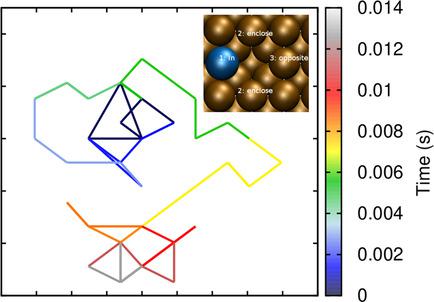当前位置:
X-MOL 学术
›
ChemPhysChem
›
论文详情
Our official English website, www.x-mol.net, welcomes your feedback! (Note: you will need to create a separate account there.)
Vacancy assisted diffusion on single‐atom surface alloys
ChemPhysChem ( IF 2.9 ) Pub Date : 2020-11-16 , DOI: 10.1002/cphc.202000838 David Mahlberg 1 , Axel Groß 1, 2
ChemPhysChem ( IF 2.9 ) Pub Date : 2020-11-16 , DOI: 10.1002/cphc.202000838 David Mahlberg 1 , Axel Groß 1, 2
Affiliation

|
Bimetallic surfaces can exhibit an improved catalytic activity through tailoring the concentration and/or the arrangement of the two metallic components. However, in order to be catalytically active, the active bimetallic surface structure has to be stable under operating conditions. Typically, structural changes in metals occur via vacancy diffusion. Based on the first‐principles determination of formation energies and diffusion barriers we have performed kinetic Monte‐Carlo (kMC) simulations to analyse the (meta‐)stability of PtRu/Ru(0001), AgPd/Pd(111), PtAu/Au(111) and InCu/Cu(100) surface alloys. In a first step, here we consider single‐atom alloys together with one vacancy per simulation cell. We will present results of the time evolution of these structures and analyse them in terms of the interaction between the constituents of the bimetallic surface.
中文翻译:

空位辅助扩散在单原子表面合金上
通过调整两种金属组分的浓度和/或排列,双金属表面可以表现出改善的催化活性。但是,为了具有催化活性,活性双金属表面结构必须在操作条件下稳定。通常,金属的结构变化是通过空位扩散发生的。基于对形成能和扩散势垒的第一性原理的确定,我们进行了动力学蒙特卡洛(kMC)模拟,以分析PtRu / Ru(0001),AgPd / Pd(111),PtAu / Au的(亚)稳定性(111)和InCu / Cu(100)表面合金。第一步,在这里我们考虑单原子合金以及每个模拟单元一个空位。
更新日期:2021-01-07
中文翻译:

空位辅助扩散在单原子表面合金上
通过调整两种金属组分的浓度和/或排列,双金属表面可以表现出改善的催化活性。但是,为了具有催化活性,活性双金属表面结构必须在操作条件下稳定。通常,金属的结构变化是通过空位扩散发生的。基于对形成能和扩散势垒的第一性原理的确定,我们进行了动力学蒙特卡洛(kMC)模拟,以分析PtRu / Ru(0001),AgPd / Pd(111),PtAu / Au的(亚)稳定性(111)和InCu / Cu(100)表面合金。第一步,在这里我们考虑单原子合金以及每个模拟单元一个空位。


























 京公网安备 11010802027423号
京公网安备 11010802027423号